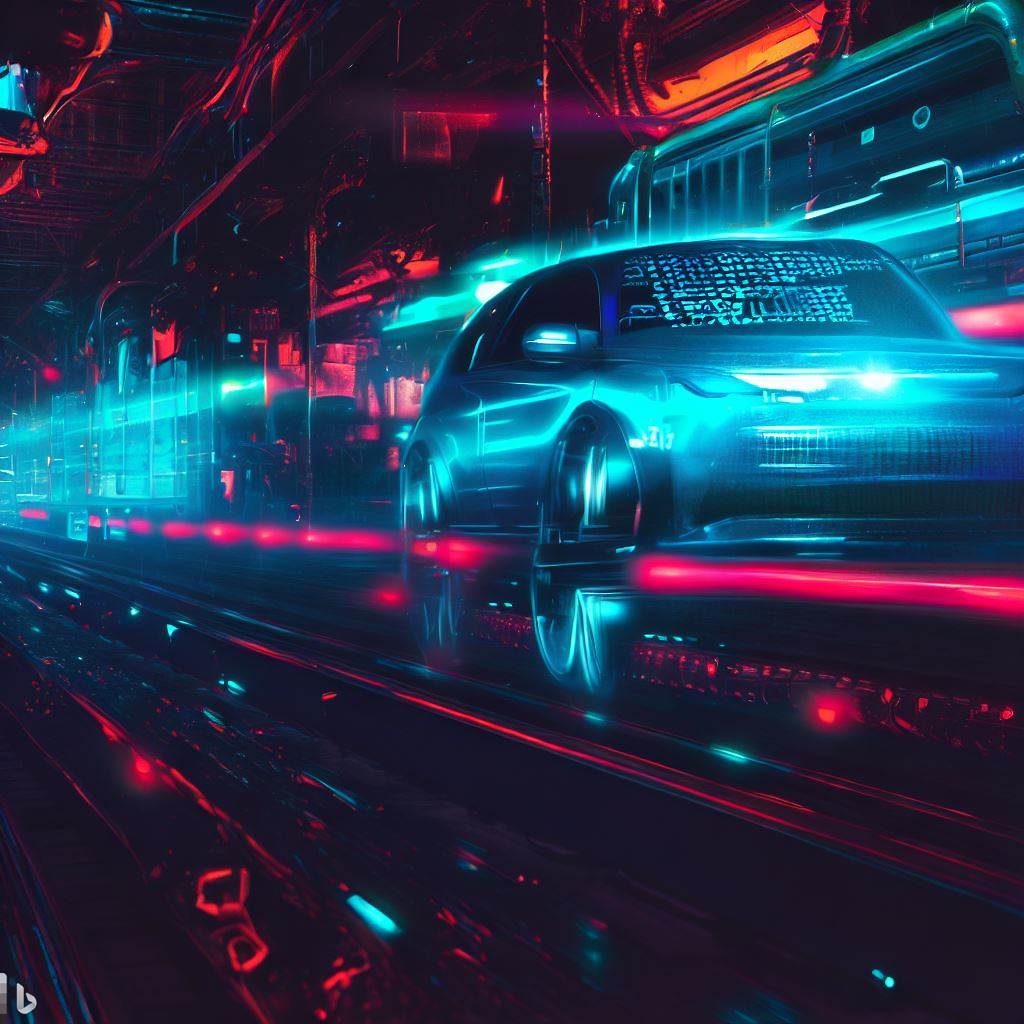Contents
Introduction to AI in Transportation and Logistics
Artificial Intelligence (AI), once a concept confined to the realms of science fiction, is now a transformative force in the real world. At its core, AI is a constellation of technologies that enables machines to perform tasks that typically require human intelligence. It thrives on data, learning from patterns, and continuously improving its operations. Today, industries across the globe leverage AI to optimize processes, uncover insights, and forge innovative solutions. One of the sectors standing at the forefront of this revolution is transportation and logistics.
Transportation, vital for our daily commutes and global trade, and logistics, crucial for timely deliveries and supply chain, are undergoing transformative changes with AI. From self-navigating vehicles alleviating traffic challenges to smart algorithms forecasting warehouse stock, the implications of AI are steering the industry towards unprecedented horizons. This article explores the myriad ways AI impacts transportation and logistics, highlighting its revolutionary potential. As we navigate this fusion, we unveil the wonders of an interconnected, efficient, and sustainable ecosystem molded by the implications of AI.

From Horses to Horsepower: The Evolution of Transportation and Logistics
Before the era of Artificial Intelligence, the transportation and logistics industries operated within the constraints of manual processes and human-led decision-making. Transportation, for centuries, depended on physical stamina – from horse-drawn carriages to human-pulled rickshaws. Even after the advent of motor vehicles, the planning and coordination of routes largely depended on human expertise and intuition. Similarly, logistics was a game of experience and judgement. Warehouses brimmed with paper logs, and supply chains were orchestrated through phone calls, ledgers, and face-to-face negotiations. The margin for error was vast, inefficiencies were common, and scalability was a challenge.
However, the winds of change began to blow with the dawn of the digital age. The initial stages of technological integration saw the introduction of computer systems that could manage large databases, automating tasks like inventory tracking and basic route optimization. GPS systems transformed the landscape of transportation, allowing for real-time tracking and more efficient route planning. The logistics sector began its gradual shift from reactive to proactive operations with the help of early predictive analytics tools. While these were significant leaps forward, they were just precursors to the profound transformations that AI would soon bring. As we progressed into the 21st century, the stage was set for AI to take these industries from efficiency to innovation, crafting a future that once lay only in the realms of imagination.
AI’s Role in Shaping Modern Transportation
The transformative power of Artificial Intelligence is no longer a speculative concept but a living reality. As we fast-forward into an era where efficiency, safety, and sustainability drive transportation needs, AI emerges as the guiding force. This metamorphosis is visible in traffic management, vehicle operations, and even the dynamics of public transportation.
Traffic Management and Smart Cities
Smart cities, envisioned as the urban centers of the future, integrate multiple information and communication technology (ICT) solutions to manage a city’s assets seamlessly. AI plays a pivotal role in this vision, especially in managing the lifeblood of any metropolis: its traffic.
- Predictive Analytics for Traffic Flow Optimization: Gone are the days when traffic updates were reactive. Now, using vast datasets from cameras, mobile devices, and IoT sensors, AI models can predict congestion, suggesting optimal routes to drivers even before they hit the road. This not only saves precious commuting time but also reduces emissions from idling vehicles.
- Adaptive Traffic Signals: Traditional traffic lights operate on fixed timers, often causing unnecessary delays. With AI, traffic signals become sentient. They adapt in real-time, analyzing traffic flow and adjusting signal durations accordingly. The result? Smoother transitions at intersections and reduced wait times.
- Parking Management Solutions: Finding a parking spot in bustling cities is akin to finding a needle in a haystack. AI-driven parking solutions alleviate this challenge. By analyzing data from various sources, these systems guide drivers to available spots, optimizing parking space usage and decreasing urban congestion.
Vehicle Automation and Safety
As technology advances, the dream of autonomous vehicles on our roads is inching closer to reality. Beyond the marvel of self-driving, AI’s embrace in vehicular safety and maintenance offers a multi-pronged transformation.
- Self-driving Vehicles: Autonomous vehicles, equipped with myriad sensors and cameras, utilize AI algorithms to process this information in real-time, enabling them to navigate, recognize obstacles, and make split-second decisions. Such vehicles promise to reduce accidents caused by human error, provide mobility solutions for those unable to drive, and revolutionize transport logistics.
- Advanced Driver-Assistance Systems (ADAS): Even before fully autonomous vehicles populate our streets, ADAS is enhancing driver safety. Features like lane departure warnings, automatic braking, and blind-spot detection are increasingly standard in modern cars. These systems employ AI to analyze real-time data, helping prevent potential accidents and ensuring a safer driving experience.
- Predictive Maintenance for Vehicles: Rather than relying on standardized service intervals or waiting for a breakdown, AI can now predict when parts of a vehicle are likely to fail. By analyzing data from onboard sensors, these systems notify drivers or fleet managers in advance, ensuring timely maintenance and reducing unexpected downtimes.
Public Transport and Shared Mobility
Public transportation and shared mobility services, from buses to ride-shares, are experiencing a sea change under AI’s influence. Optimizing routes, forecasting demand, and personalizing rides are just the tip of the iceberg.
- Predictive Analytics for Demand Forecasting: Traditional public transport often operated on static schedules, leading to overcrowded services during peak times and near-empty ones during off-peak hours. With AI’s predictive analytics, transport agencies can anticipate passenger demand, adjusting service frequency accordingly. This ensures better utilization of resources and a more comfortable commute for passengers.
- Real-time Route Optimization: Static routes in public transport are becoming obsolete. AI-driven algorithms can now modify routes in real-time based on current traffic conditions, events, or unexpected disturbances. This means fewer delays and more punctual arrivals.
- AI-driven Ride-sharing Algorithms: The rise of ride-sharing platforms has reshaped urban mobility. AI is at the heart of these platforms, matching riders with drivers, determining optimal pickup and drop-off points, and even setting dynamic pricing based on demand and supply. This intelligent matchmaking ensures efficient use of vehicles, reduced trip durations, and an overall better experience for users.
As the domains of AI and transportation continue to intertwine, the outcomes are multifaceted and transformative. From the roads we drive on to the way public transport systems operate, AI’s fingerprints are unmistakable. It’s a journey towards a more connected, efficient, and sustainable transportation future, and AI is firmly in the driver’s seat.
Reimagining Logistics: The Pivotal Role of AI
The logistics sector, a keystone of modern commerce and trade, is undergoing a monumental transformation. From warehouse floors to the complexities of supply chains, and right up to customer interactions, Artificial Intelligence is introducing efficiencies and capabilities hitherto unimagined. This metamorphosis is not just about speed or precision, but a holistic reimagining of processes, driven by data and intelligent algorithms.
Warehouse Management
In the vast expanse of modern warehouses, efficient operations are crucial. Missteps can lead to costly delays or inventory mishaps. AI is stepping in to ensure that warehouses are not just storage spaces, but dynamic hubs of smart operations.
- Robot-assisted Picking and Sorting: Gone are the days of manual, time-consuming picking of items. Today, AI-powered robots traverse warehouse floors, picking, sorting, and placing items with impeccable precision. These robots can work round the clock, ensuring that operations are swift and continuous, meeting the demands of today’s rapid commerce cycles.
- Inventory Forecasting Using AI: Overstocking leads to wasted resources, while understocking can result in lost sales. AI-driven inventory forecasting analyzes past sales data, seasonal trends, and even external factors like economic indicators to predict stock requirements. This ensures optimal stock levels, reducing carrying costs and ensuring product availability.
- Space Optimization through AI-driven Design: Warehouses are now being designed or retrofitted with AI recommendations. Using data on the movement of goods, frequency of picks, and the nature of inventory, AI algorithms can suggest optimal layouts, ensuring that space is utilized efficiently and goods are accessible with minimal movement.
Supply Chain Optimization
The modern supply chain is a complex web of operations, and even minor disruptions can lead to significant repercussions. AI acts as the guardian, optimizing, predicting, and monitoring every facet.
- Demand Forecasting: One of the fundamental challenges in supply chain management is predicting demand. AI algorithms can process vast amounts of data, from sales history to market trends, to forecast demand with enhanced accuracy. This ensures that businesses are prepared, reducing wastage and capitalizing on market demands.
- Route Optimization for Delivery Trucks: The journey from the warehouse to the consumer’s doorstep isn’t linear. With dynamic traffic conditions, road closures, and multiple delivery points, efficient routing is crucial. AI-driven route optimization tools analyze real-time data to provide drivers with the most efficient routes, ensuring timely deliveries and reduced fuel consumption.
- Real-time Monitoring of Goods with AI-powered Sensors: The status and condition of goods, especially perishables or fragile items, during transit are paramount. AI-powered sensors embedded in packages can relay real-time information about temperature, humidity, or even potential tampering. This not only ensures product integrity but also provides invaluable data for continuous supply chain improvement.
Customer Service Enhancement
In the age of instant gratification, customer expectations are sky-high. Quick responses, accurate delivery timelines, and personalized interactions are no longer a luxury but a baseline requirement. AI is at the forefront, ensuring businesses rise to the occasion.
- Chatbots for Real-time Tracking and Support: Gone are the days of long wait times on customer support calls. AI-driven chatbots, available 24/7, provide instant responses to customer queries, from package tracking to addressing concerns. With their ability to process vast amounts of data rapidly, these chatbots offer precise, relevant information, enhancing the customer experience.
- Predictive Analytics for Better Delivery Time Estimation: “When will my package arrive?” is a common customer query. With AI’s predictive analytics, businesses can provide more accurate delivery windows. By analyzing factors like route efficiency, weather conditions, and historical delivery times, customers are given a realistic and often precise delivery timeline.
- Personalized Marketing and Sales Strategies: Every customer is unique, and AI ensures they’re treated that way. By analyzing purchasing history, browsing patterns, and even social media interactions, AI can tailor marketing campaigns to individual preferences. This not only increases sales potential but also fosters brand loyalty.
As AI continues to integrate itself into the logistics sector, it’s clear that its impact is multifaceted and profound. What emerges is a logistics landscape that’s more responsive, efficient, and attuned to both business and customer needs. The age of intelligent logistics isn’t on the horizon; it’s here, and it’s revolutionizing the way we think about the movement of goods and customer interactions.
Ethical and Socio-economic Considerations
The integration of Artificial Intelligence into the transportation and logistics sectors offers undoubted efficiencies and innovations. However, as with any transformative technology, there are ethical and socio-economic implications that need to be addressed to ensure its sustainable and responsible adoption.
Job Displacement vs. Job Creation
A major concern echoed in boardrooms and worker unions alike is the potential for AI to replace traditional jobs. Automated warehouses, self-driving trucks, and AI-driven customer service platforms might lead to fears of massive unemployment in roles previously held by humans.
- The Debate Surrounding AI Taking Over Traditional Jobs: The apprehension is real. For instance, truck driving, one of the most common occupations in many countries, is directly threatened by the advent of autonomous vehicles. Similarly, warehouse roles might reduce with the increase of robot-assisted sorting and picking. As AI systems become more adept at handling complex tasks, there is a legitimate concern over the shrinking opportunities for human involvement in various capacities.
- The Emergence of New Job Roles and Upskilling Opportunities: However, history has shown that while technology can displace certain jobs, it also births new ones. The AI revolution is expected to create roles we haven’t yet envisioned. Moreover, with the right training and upskilling, workers can transition to managing and maintaining these AI systems. For instance, an experienced driver might become invaluable in training an autonomous driving algorithm, providing real-world insights that machines can’t inherently know. The key lies in proactive adaptation and ensuring that workers are equipped with the skills for the AI-driven future.
Data Privacy and Security
AI thrives on data. The transportation and logistics sectors are becoming increasingly data-centric, gathering copious amounts of information ranging from customer details to real-time vehicle locations.
- The Implications of Gathering and Processing Vast Amounts of Transportation and Logistic Data: As supply chains become smarter and transportation systems more interconnected, the amount of data generated and processed is astronomical. This poses questions about who has access to this data, how it’s used, and its implications for individual privacy. A delivery truck’s route, for instance, might inadvertently reveal a business’s key clients or strategic priorities.
- Measures to Ensure Data Protection and Cybersecurity: The safeguarding of this data becomes paramount. Companies need to employ advanced encryption methods, robust cybersecurity protocols, and ensure transparency in how they process and use data. It’s not just about preventing hacks or data breaches; it’s about ensuring public trust in an era where data is the new currency.
Safety and Reliability Concerns
The promise of AI in making transportation and logistics more efficient is accompanied by the critical responsibility of ensuring that these systems are safe and reliable.
- The Challenge of Ensuring AI Systems are Foolproof: An autonomous vehicle, for instance, has to make split-second decisions that can have life or death implications. How do we ensure that the AI is trained adequately for every possible scenario? Similarly, in logistics, an error in an AI-driven inventory system might result in significant financial losses or supply chain disruptions.
- Real-world Consequences of Potential AI Errors: Unlike errors in many other domains, mistakes in transportation and logistics can have immediate, tangible consequences. An autonomous vehicle misinterpreting a signal could lead to accidents. A misjudgment by an AI-driven traffic management system might cause massive traffic jams. Therefore, while embracing AI, it’s vital to have robust testing, continuous monitoring, and rapid response mechanisms to address any anomalies.
The potential of AI in reshaping transportation and logistics is immense, promising a future of increased efficiency, sustainability, and innovation. However, this journey needs to be undertaken with a keen awareness of its ethical and socio-economic implications. By proactively addressing concerns related to job displacement, data privacy, and safety, we can ensure a harmonious integration of AI that benefits industries and societies at large.
Case Studies from the Frontline
The impact of AI in the transportation and logistics sectors is undeniable. While the promise of this technology is vast, its real-world applications yield a spectrum of results. Exploring specific case studies offers a granular view into its potential, spotlighting both transformative successes and cautionary tales.
Success Stories
One cannot talk about AI in transportation without mentioning the pioneering work of companies like Tesla and Waymo.
Tesla, in its bid to create a fully autonomous car, has integrated advanced AI systems to process data from the vehicle’s sensors in real-time, enabling features like auto-lane change, autopilot, and predictive navigation. These innovations are transforming our perspective on personal transportation, pushing us closer to a future where cars become more autonomous and roads safer.
On the urban front, Singapore stands out. The city-state’s smart traffic management system, which harnesses AI to predict and manage traffic flow, has revolutionized urban commuting. Using predictive analytics, the system adjusts traffic light timings during rush hours, streamlining the flow of vehicles and significantly reducing congestion.
Lessons from Failures
Not all AI ventures in transportation and logistics have been rosy.
One of the cautionary tales comes from the early trials of autonomous freight transport. Uber’s self-driving truck division, after much fanfare, faced a series of technical and regulatory challenges. While the trucks did complete some successful runs, the program was eventually shelved in 2018. The primary takeaway? The technical complexity of scaling autonomous driving in varied environments is immense. It also underscored the importance of thorough testing and the need for a more phased integration of such technologies into real-world scenarios.
Another example can be seen in some initial attempts to fully automate warehouses using AI and robotics. Companies, in their zest to automate, overlooked the nuanced and adaptive nature of human labor. When robots faltered in handling unpredictable scenarios or unique package shapes, the entire chain got disrupted. The lesson was clear: while AI can bring efficiency, a balanced human-machine collaboration often yields the best results.
While AI’s potential in transforming transportation and logistics is undebatable, its effective implementation requires a blend of technological foresight, adaptability, and a keen understanding of the intricate dance between man and machine. As showcased by these case studies, there is no shortcut to reaping AI’s rewards, but with due diligence, its benefits can be monumental.
Navigating the Future
The advent of Artificial Intelligence has undeniably set the transportation and logistics sectors on an exciting trajectory. Yet, the journey has only just begun. As we look to the horizon, a confluence of emerging technologies, environmental imperatives, and global collaboration is shaping the roadmap for the future of this industry.
Integration with Other Emerging Technologies
Innovation doesn’t exist in silos, and the synergy between AI and other cutting-edge technologies promises to redefine the landscapes of transportation and logistics.
- The Role of IoT, 5G, and Blockchain alongside AI: The Internet of Things (IoT) is propelling the sector into an era of unprecedented connectivity. Vehicles, shipping containers, and even individual packages can now communicate their status, position, or condition in real-time. When integrated with AI, this data can lead to transformative optimizations. Coupled with the lightning speed of 5G networks, this amalgamation ensures real-time data transmission and processing, making operations seamless and highly responsive. Blockchain enters the scene as a guardian of data integrity and security, creating tamper-proof records of transactions, shipments, or any logistic operation. This triad of AI, IoT, and blockchain, fortified by 5G, is setting the stage for a logistics revolution.
- Potential of Quantum Computing in Logistics Optimization: Quantum computing, with its prowess to process complex computations in seconds, is poised to tackle logistics challenges that are currently too intricate for classical computers. Imagine optimizing delivery routes considering not just traffic, but weather patterns, dynamic demand surges, or even geopolitical events. The computational might of quantum computers can make these daunting tasks feasible, pushing logistic efficiencies to new frontiers.
Environmental and Sustainability Impacts
The green revolution is not a choice; it’s a necessity. As industries worldwide grapple with environmental challenges, AI emerges as a beacon of hope.
- AI’s Role in Promoting Green Logistics and Eco-friendly Transport Solutions: AI-driven route optimizations can significantly reduce fuel consumption, leading to decreased greenhouse gas emissions. Smart traffic management systems, informed by AI, can mitigate congestion, further decreasing carbon footprints. Additionally, AI-powered predictive maintenance can extend vehicle life spans and reduce waste. In the broader logistics ecosystem, AI can help in designing eco-friendly packaging, optimizing storage to reduce energy consumption, or even in streamlining reverse logistics for efficient recycling and waste management.
Global Collaboration and Standards
In a globally interconnected world, the adoption and success of AI in transportation and logistics can’t be localized endeavors.
- The Need for Global Standards and Interoperability for Large Scale AI Implementation: As AI systems become commonplace in vehicles, shipping operations, or air traffic controls, there’s an increasing need for these systems to communicate and understand each other, irrespective of geographical boundaries. Creating universal standards ensures that an AI-driven logistics solution developed in one part of the world can seamlessly operate elsewhere. This not only paves the way for smoother global trade operations but also ensures that innovations and best practices can be rapidly adopted worldwide.
The future of transportation and logistics, underpinned by AI, is not just about speed or efficiency. It’s about creating a responsive, sustainable, and globally harmonized ecosystem that can cater to the demands of the 21st century and beyond. With emerging technologies as allies and a shared global vision, the road ahead is both promising and exhilarating.
Conclusion
The transformative potential of Artificial Intelligence in transportation and logistics is akin to the advent of the steam engine or the assembly line – monumental shifts that ushered in new eras. AI’s prowess promises efficiencies, innovative solutions, and a level of precision previously considered unattainable. From self-driven vehicles traversing our highways to AI-orchestrated supply chains that respond in real-time to dynamic global demands, the evolution is palpable and profound.
However, as we stand at this juncture of change, it is imperative to exercise prudence. The allure of AI’s capabilities must not overshadow the ethical dilemmas and socio-economic considerations it brings forth. Job displacements, data privacy concerns, and the very reliability of AI-driven systems in life-critical scenarios are challenges we must confront head-on. It is a gentle reminder that technology, no matter how advanced, should be tailored to serve humanity and not the other way around.
Thus, our foray into this AI-enhanced future must be characterized by mindful adoption. We need to prioritize human-centric design – where AI complements human effort rather than competes with it. We must uphold ethical standards, ensuring that the AI systems we integrate are transparent, accountable, and aligned with societal values.
In essence, while AI paints a future replete with possibilities for transportation and logistics, it is upon us to navigate this journey with caution, empathy, and a steadfast commitment to the greater good.


